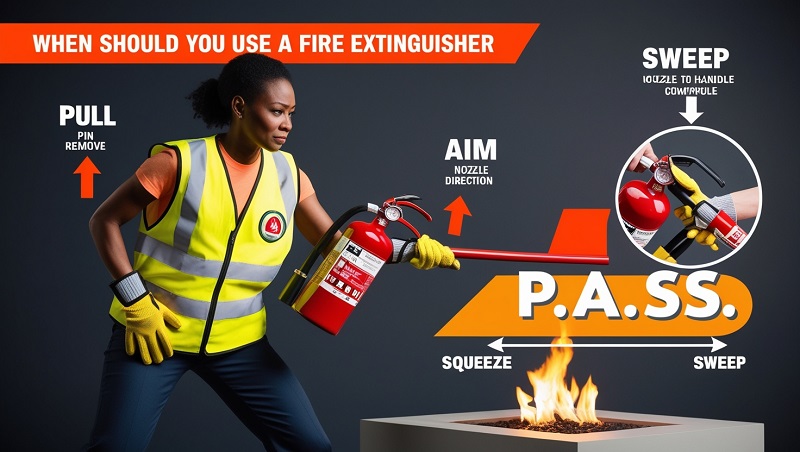Fire extinguishers are powerful tools that can help put out small fires before they escalate into dangerous and uncontrollable situations. However, knowing when and how to use a fire extinguisher is critical for ensuring safety. This comprehensive guide explains the right scenarios to use a fire extinguisher, the factors to consider, and steps to take for effective and safe usage.
What is a Fire Extinguisher?
A fire extinguisher is a portable device designed to combat small fires. It works by discharging a substance – such as water, foam, carbon dioxide, or dry powder – to suppress or extinguish flames. Each fire extinguisher is made for specific types of fires, classified into categories based on the materials burning.
Fire Classes and Their Corresponding Extinguishers
Before using a fire extinguisher, it’s important to know the type of fire you’re dealing with. Fires are classified as follows:
- Class A: Fires involving ordinary combustibles like wood, paper, cloth, and plastics.
- Class B: Fires involving flammable liquids such as gasoline, oil, and grease.
- Class C: Fires involving energized electrical equipment like wires, circuit breakers, and appliances.
- Class D: Fires involving combustible metals like magnesium, titanium, or sodium.
- Class K: Fires involving cooking oils and fats, commonly found in commercial kitchens.
Using the wrong extinguisher can be dangerous. For instance, using a water-based extinguisher on an electrical fire (Class C) may result in electric shock, while using it on grease fires (Class K) can cause the fire to spread.

When Should You Use a Fire Extinguisher?
Fire extinguishers are most effective when used in the right circumstances. Consider the following factors before attempting to use one:
1. The Fire is Small and Contained
- A fire extinguisher should only be used for fires in their incipient stage, meaning they are small and confined to a single area (e.g., a wastebasket or stovetop fire).
- If the fire is spreading or larger than what you can handle, evacuate immediately and call emergency services.
2. You Have a Clear Escape Path
- Ensure you have an unobstructed and safe exit route before using a fire extinguisher.
- Never let the fire block your way out. If it does, evacuate immediately.
3. The Right Fire Extinguisher is Available
Use the correct type of fire extinguisher for the fire. For example:
- Use a Class B extinguisher for flammable liquids.
- Use a Class C extinguisher for electrical fires.
- For cooking fires, a Class K extinguisher is most effective.
4. You Feel Confident and Are Trained
- Use a fire extinguisher only if you are confident in its operation. Without proper training, using an extinguisher could be dangerous.
- If you feel unsure or overwhelmed, prioritize evacuation and contact emergency services.
5. The Environment is Safe
- Avoid using a fire extinguisher if the fire is creating thick smoke or if toxic fumes are present. Smoke inhalation is a leading cause of fire-related deaths.
- If visibility is compromised or the room fills with smoke, leave immediately.
How to Use a Fire Extinguisher: The P.A.S.S. Method
To safely and effectively use a fire extinguisher, follow the P.A.S.S. method:
- Pull the Pin: Pull out the safety pin to break the seal.
- Aim Low: Point the nozzle or hose at the base of the fire, where the flames are being fueled.
- Squeeze the Handle: Squeeze the handle to release the extinguishing agent.
- Sweep Side to Side: Move the nozzle in a sweeping motion across the base of the fire until it is extinguished.
When Not to Use a Fire Extinguisher
Knowing when not to use a fire extinguisher is equally important:
1. The Fire is Too Large
- Fires larger than a small wastebasket or those spreading rapidly are too big to handle with a fire extinguisher. Evacuate immediately and call 911.
2. The Area is Unsafe
- If the fire creates significant smoke, blocks your exit, or is near hazardous materials, prioritize your safety and evacuate.
3. You Lack the Right Extinguisher
- Using the wrong extinguisher can make the fire worse. For example:
- Using a water extinguisher on an electrical or grease fire can create additional hazards.
- Dry powder extinguishers can reduce visibility and cause breathing difficulties in enclosed spaces.
4. You Are Untrained or Unsure
- If you’re not trained or confident in using a fire extinguisher, it’s safer to leave firefighting to professionals.
Fire Extinguisher Placement and Maintenance
Proper placement and maintenance of fire extinguishers are essential for their effectiveness:
1. Placement
- Place fire extinguishers in accessible areas near potential fire hazards:
- Kitchens, garages, and near exits in homes.
- Hallways, workshops, and electrical rooms in workplaces.
- Avoid placing extinguishers near heat sources where they could become damaged.
2. Regular Inspections
Inspect fire extinguishers monthly for the following:
- Proper pressure on the gauge.
- An intact safety pin and tamper seal.
- No visible damage or corrosion.
3. Annual Servicing
- Have fire extinguishers professionally inspected and serviced at least once a year.
- Replace extinguishers that are expired, damaged, or discharged.
Legal and Workplace Considerations
In workplaces, fire extinguishers must comply with local safety regulations:
- Employers are required to provide training on the use of fire extinguishers.
- Conduct regular fire drills to ensure employees know when and how to use extinguishers.
- Follow OSHA guidelines for fire extinguisher placement, maintenance, and usage.
Conclusion
Fire extinguishers are invaluable tools for managing small fires, but knowing when and how to use them is crucial for safety. Always assess the fire’s size, ensure a clear escape route, and use the correct extinguisher for the situation. If there is any doubt about your ability to handle the fire safely, evacuate immediately and contact emergency services.
Remember, while fire extinguishers can save lives and property, your safety is the top priority.
>>> Read more: What Are the Types of Fire Extinguishers?
